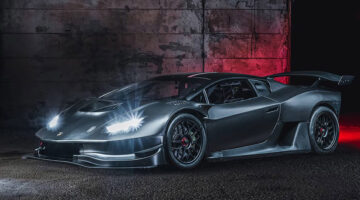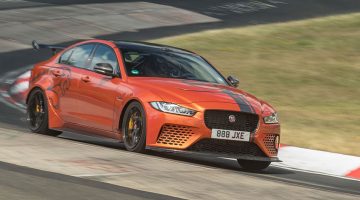From the edge of the Arctic Circle to the scorched earth of Death Valley via Nardò and the Nürburgring, these are some of the key locations where manufacturers put new cars through their paces.
Development and pre-production cars are subjected to long and intense testing regimes before any new model ever goes on sale. Creating the extreme conditions required to test cars to their limits, and beyond, means travelling to some equally extreme locations with the scope and climate for the job.
Cars need to remain functional in climatic conditions where most humans would find it impossible to survive. They must also operate under forces that far exceed those they’re likely to encounter in the hands of their eventual owners. A select group of testing facilities around the world has grown up to recreate precisely these extremes. They represent a development car’s hell on earth but, often, an engineer’s heaven.
Here we’re looking at some of the best known and most influential car testing locations on the planet, explaining the unique characteristics that each has to offer and the impact they have on the cars we drive.

Mobis Proving Ground
Arjeplog, Sweden
During the winter of 1967, two Opel engineers drove north from Germany, not stopping until they’d covered almost the entire ice-ravaged length of Sweden. They stopped at a small town called Arvidsjaur, a few kilometres short of the Arctic circle, and found lodgings at the Laponia hotel.
They had travelled north in search of extreme winter conditions to test a new engine design, not thinking beyond the length of their to-do list. They could never have imagined that, every winter for the following 50 years and beyond, the world’s car engineers would decamp to Arvidsjaur and nearby Arjeplog to test their own new technologies.
Today, with 20 or so separate test facilities and a complete infrastructure built up over five decades, the region is the epicentre of the car industry’s winter testing activities. For ten weeks each season, the population of Arjeplog triples as 2000 engineers from 30 car manufacturers and as many suppliers descend on the town.
Hyundai and Kia come each year, using a facility that belongs to their major component supplier, Mobis. They come to develop ABS and ESC systems, using snow-covered tracks and circuits carved into frozen lakes. ‘We have to cover these kinds of conditions,’ says Hyundai-Kia engineering boss Albert Biermann. ‘The range we have to master, the different levels of grip […] that is not so easy for the chassis systems.’
Being posted to the north of Sweden each winter to drive prototypes on frozen lakes sounds like a plum assignment. The bitterly cold weather and the long nights (in January the sun sets just after lunch) plus the reality of being stuck in a small town away from friends and family, however, mean it’s no holiday.
‘I was first here in 1984 with the BMW 7-series. I had heard about a frozen lake and I wanted to drive on it,’ recalls Biermann. ‘I started slowly. Then after some time you try to be Walter Röhrl. Eventually I was too enthusiastic and I span the car 12 metres off the track and into the deep snow. It was an hour of shovelling…

‘Some of our guys are out here for eight weeks or so. I think, after two weeks, being here can get boring.’
‘You don’t want to do more than a couple of weeks at a time,’ confirms Jaguar Land Rover chassis engineer Mike Hart. ‘I know one guy who did eight weeks straight. He was testing a car with three water-filled mannequins in it. He called them all Dave. He said he didn’t realise he was losing his mind until he found himself in the children’s playground in Arjeplog pushing them on the swings, laughing to himself.’
The Mobis facility was established in 2005. Its land circuits cover 3.3 hectares (one hectare being roughly the size of a football pitch), while the lake circuits are spread over 163 hectares. The Hyundai-Kia group had 120 engineers in the area this season, 20 of them working directly on the forthcoming Stinger GT performance car.
We’ve been following the Stinger GT since its unveiling late last year, and Kia invited evo to test the car on the lake, to explore its intriguing four-stage stability control system on a vast 250-metre-radius steering pad.
There’s so little grip on a frozen lake that any car will slide around a little, even with the systems on, but by and large the electronics keep the Kia in good shape. In Sport mode it will slide around a little before the computers trigger the brakes and kill the throttle to bring it back under control, preventing it from spinning. Pressing the stability control button once removes one more layer of electronic assistance. The car will still use its brakes to try to keep itself in shape, but now it won’t kill the throttle. It will spin in this mode, but you can also hold neat powerslides.
The final stage is to turn the systems off, which really means off. That turns the rear-wheel-drive Stinger GT into one of the most controllable and entertaining oversteer machines you can imagine – on this surface, at least.
There’s every chance the crucial work that goes on in northern Sweden each winter has at one time or another saved your bacon. It just so happens that ice driving is also enormously good fun… as long as you don’t hang around too long.

Nardò Technical Center
Nardò, Italy
The Pista di prova di Nardò della Fiat opened for business on 1 July 1975 and quickly became a hot spot for serious vehicle testing in a part of Italy not noted for much apart from its largely unchanging sunny climate. Built by Fiat in the southern region of Apulia, and kissing the coast of the Ionian Sea, the spacious facility was eventually bought by Porsche Engineering in 2012 and renamed – rather less long-windedly – the Nardò Technical Center.
It now boasts 20 tracks to cater for just about every shakedown scenario imaginable, from extreme durability to noise, vibration and harshness (NVH) to low-friction ice simulations to near-death and actual death experiences for tyres and suspension. There are even facilities for measuring bodywork corrosion resistance.
Like the MIRA and Millbrook proving grounds in the UK, the NTC is open to all vehicle makers, as well as Porsche Engineering’s many customers and, of course, the Porsche AG car division itself, though the corporate line is keen to emphasise that it affords itself no preferential treatment. For exclusive use, it has to book the time and stand in line. Nardò is, after all, an important revenue stream for Porsche.
You have to take to a helicopter to fully appreciate just how expansive Nardò’s most famous circuit is. At 12.5 kilometre in circumference and 4 kilometres in diameter, the constant-radius high-speed bowl looks much like you’d imagine the (admittedly much larger) Large Hadron Collider would were it exposed to the air, as it encircles not just most of the site’s other facilities but also a large slice of the surrounding countryside. The banked track has four lanes, each with its own ‘hands off’ speed where, thanks to competing physical forces, the vehicle tracks true without any need for steering input from the driver. In lane four, the lane nearest the outer edge, this is a remarkable 240kph, which makes the 160kph ‘hands off’ speed on Millbrook’s much smaller bowl seem, well, rather pathetic.
The Large Hadron Collider analogy isn’t so fanciful, either. If it’s all about speed, the NTC’s circular track is one of the few places in Europe where 320kph-plus supercars can really be let off the leash to see what happens at V-max hour after hour. It’s where the Volkswagen concept car, W12 Nardò, covered 7741 kilometres in 24 hours at an average speed of 320kph.

The 3.8-mile handling track, opened in 2006, is hardly less exciting or challenging. It comprises 16 bends (nine left-handers and seven rights), some modelled on the more celebrated of the Nordschleife’s, and one in particular – the ever-tightening, downhill left-hander at the end of the main straight, entered more or less flat at around 290kph in a 918 Spyder – has to be among the greatest ever, making Laguna Seca’s legendary Corkscrew seem a walk in the park by comparison. Porsche ambassador and superhand Walter Röhrl absolutely loves the track.
But even that isn’t NTC’s principal lure. As it always has been, it’s the consistency of the sun and dry tarmac all year round, assets that don’t only mean stable and efficient testing conditions on demand but also an ever-ready queue of Porsche personnel willing to tough it out for the greater good. And Nardò seldom disappoints. When it isn’t possible to test at the Nürburgring, a more frequent occurrence than you might imagine, Nardò’s accommodating climate provides the natural default location for Porsche’s evaluation programmes. It’s the same for Jaguar, Aston Martin, Audi and Lamborghini. In fact, nearly all of Europe’s car makers have test facilities at the NTC.
And those facilities will expand in the coming years. The high-speed bowl is being completely resurfaced to eradicate the ostensibly minor lumps and bumps that are seriously amplified at 320kph or so. There will be new off-road tracks and dirt roads emulating the worst Africa has to offer, too.
Perhaps the enduring appeal of Nardò is best summed up by Bugatti’s head of chassis development, Florian Umbach: ‘I was very impressed when I drove for the first time with our Bugatti Veyron Super Sport over the big jump on the great handling track, just facing the blue sky and the amazing view of the sea.’

Nürburgring
Germany
Production car lap record runs grab the headlines in the specialist press but they’re a tiny percentage of the mileage that manufacturers rack up on exclusive ‘Industry Pool’ days at the Nürburgring Nordschleife. Why go there at all, you might ask, given that there are virtually no places in the world where you can drive flat out on an endless one-way road that twists like the Targa Florio?
Well, car makers like to speed up development to find out if systems and components are robust, and the pace of the Nordschleife, combined with its bumps and elevation changes, is reckoned to make each 12.9-mile lap the equivalent of about 322 kilometres of normal road driving. If you’ve been there in your own car, you’ll know that it is gently but insistently stressful, and that’s why you’ll see as many ‘vanilla’ cars there as you do high-performance models.

Ladoux
France
Among the many test tracks at Michelin’s facility at Ladoux, just north of Clermont-Ferrand in central France, is one of the finest wet handling circuits we’ve tried and a simple yet remarkably revealing dry handling track. In combination, they make assessment of a car’s base handling characteristics a 20-minute job and offer excellent opportunities for fine-tuning a car’s traction and stability control systems.
Tucked away behind a scruffy industrial estate, the vast Michelin facility is by contrast as neat as a model railway, the approach to its main entrance via a bowstring bridge over a section of the looping high-speed track. The wet handling circuit is the big draw though, being wide, weir-fed – no need for wipers – and concocted of such curves and cambers that you find yourself grappling with lift-off oversteer without looking for it. It’s where Richard Hammond ‘learned’ to drift in episode 13 of The Grand Tour.

Ehra-Lessien
Germany
If you want to run a road car at very high speed – well over 320kph – your options are scant. The best place in the world is Ehra-Lessien in Germany with its 8.7km (5.4-mile) straights and long, banked links that permit a fast entry and exit. It sounds tailor-made for the current era of 400kph-plus road cars but is, in fact, a Cold War relic, built in what was a no-fly zone near the former East German border.
It’s owned today by the Volkswagen Group – a fact that some reckon gives the group’s Bugatti brand an advantage over every other car maker who fancies a pop at the title of World’s Fastest Production Car. It’s one of the few places where 400kph-plus can be achieved – Nardò’s huge bowl comes with an unhelpful cornering load, while Papenburg in north Germany has straights of ‘only’ 4km – and it’s rare for other car makers to be granted access.

Death Valley
United States
All car makers have access to test cells that can reproduce the harshest of environments, be they extreme heat, cold or humidity, but there’s nothing so thorough as actually being there and driving the test car, which is why Death Valley National Park in California, USA, is still one of the must-visit new-car development destinations. Its searing heat tests everything on the car, from the obvious such as the engine cooling system and the capacity and functionality of the cabin air conditioning, to the unexpected such as the glue sticking the rear-view mirror to the windscreen. It’s hottest in July and August, with average temperatures of 115-117deg F (46-47deg C), which makes it a test of the engineers as well as the cars, not to mention the photographers who camp out to ‘scoop’ the latest prototypes.
This article originally appeared at evo.co.uk



